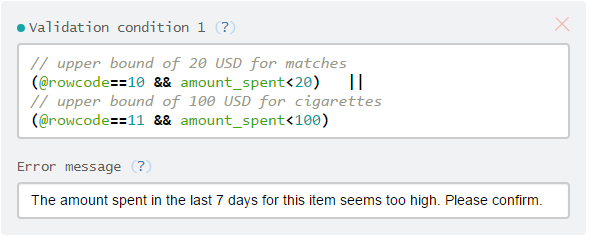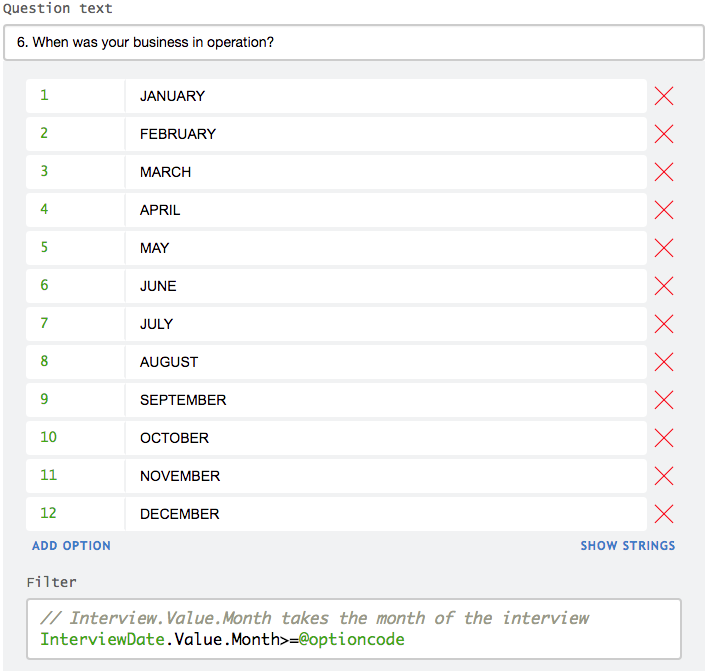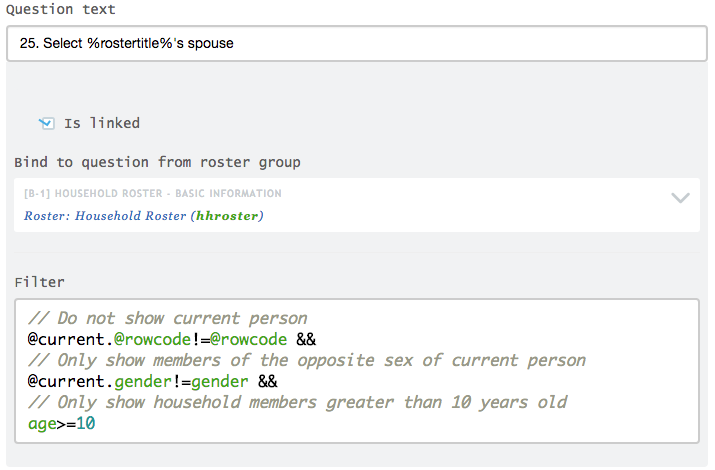These are variables that are created by Designer to allow the user
to refer to certain variables or lines in a roster in enabling
conditions or
validation
conditions. More
detail is provided below about useful system variables:
self, @rowcode, @optioncode, and
@current.
self
For validation conditions, a very useful system generate variable is self. This variable denotes the value of the question being validated. Using self instead of the question’s variable name in a question’s validation conditions is advised because you will not have to change the variable name in the validation condition if the variable name for the question is changed.
It is important to note that using self in the enabling condition will cause an compile error.
Example:
You have a question “How many rooms does this house have?” with the
variable name num_rooms. If
the value 0 is not an acceptable answer for this question, then you can
write either num_rooms>0 or
self>0 as a
validation condition for this question. The two expressions are
equivalent.
@rowcode
This system generated variable allows you to reference specific rows within a roster. This variable can be used in enabling conditions and validations. Additionally, @rowcode can also be used to refer to certain rows in a look up table.
Example 1:
Assume you have roster of items and you have a question that should only
be asked of two of the items (item #110 and item #114). In this case,
you would use @rowcode to
refer to the item number. Then you would use @rowcode and
write the enabling condition to be like below:

Example 2:
Assume you have a roster of items that the household could have bought
in the last 7 days. You want to check that the amount of money spent is
not too high. Two of the items on the list are matches (item# 10) and
cigarettes (item #11). Cigarettes are more expensive than matches
so the largest amount that could be spent would be different for each
item. Assume that you want an upper bound of 20 USD for matches and 100
USD for cigarettes. You would
use @rowcode to code the upper bound specific to that
item. To code this check, you would write the validation
condition to be like below:
@optioncode
This system generated variable, @optioncode, is used to filter answer options for single select questions and multi-select questions. @optioncode refers to the numeric code for each answer option.
Example:
Assume you have a question that asks when in the past calendar year a
business has been in operation. You want to filter the answer options so
that only the months in the past appears. For example, if the
interviewer occurs in October, you do not want the month November and
December to appear because those are months in the future. Assume you
have a question that captures the the date of the interview (InterviewDate).
You will use date time functions to code this filter. You should write
the filter to look like below:

The code InterviewDate.Value.Month takes the numeric month value from the InterviewDate variable. The filter will be evaluated for every option code and it will only display the options that it evaluate to true. In this case, months in the future will evaluate to false and will not appear as an answer option.
@current
This system generated variable, @current, is very useful in code to filter answer options. @current refers to the current line or occurence in the roster. For example, @current refers to the current household member that you are on in the household roster.
Example:
Assume you have a question that asks the interviewer to select the ID of
the spouse of the current household member. You want to filter the
answer options based on the following criteria:
- Do not show the current person
- Only show household members of the opposite gender
- Only show household members 10 years old or greater
This question is a single select linked to the household roster. For
this example, assume that the variable for the gender of the household
member is gender. You
would write the filter for the answer options to look like this:
To see an example of this code in a public questionnaire.
